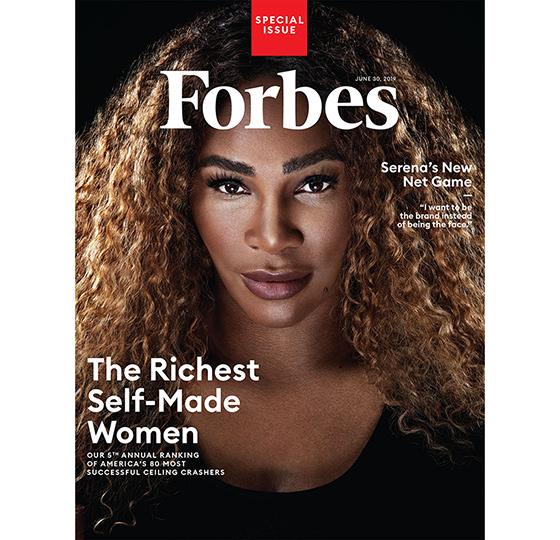
Forbes has redesigned its print magazine for the first time in eight years, modernizing the design and curating editorial to produce a more streamlined package and reading
experience.
Chief Content Officer Randall Lane revealed the changes to the magazine at an event held at the Forbes on Fifth event space Tuesday night.
The changes
debuted in Forbes’ fifth annual “Self-Made Women Issue,” which spotlights the most successful women entrepreneurs and executives, measured by their net worth.
Serena Williams is on the cover. The feature on the
professional tennis player details her venture investments in a number of ecommerce, food, fashion and health businesses.
advertisement
advertisement
Williams is a “fresh business story,” Chief Content
Officer Randall Lane said, because she is “young and well-known.” It is her first time on the list.
This year's list is its longest, with 80 women. (The list originally started
with 50.) The goal is to grow the franchise to include 100 self-made women, said Luisa Kroll, Forbes assistant managing editor.
This was the right time to modernize the 100-year-old
magazine, Lane said. “Forbes sits at historic highs” for its print, digital and social audience. The magazine has about 6 million print readers; Forbes.com has roughly 70
million.
“We wanted to reinvent the magazine from a position of strength, to be proactive,” Lane told Publishers Daily.
The updates to the print magazine were made
with the understanding that people are consuming the majority of content on their phones.
“When you can receive an infinite amount of information on your phone or computer and then
share, bookmark or link out of it, what drives a superior print magazine experience — something you would rather consume in a glossy, portable format than any other?” Lane wrote in a post on Forbes.com announcing the changes.
The key to that experience is curation: “concisely bringing together a full meal of facts and ideas that contrast with the à la carte nature of digital surfing,” he wrote.
For example, many of the pages in Forbes now have an “Easter egg,” Lane said - a tidbit from successful entrepreneurs that is loosely connected to the content on the page. The
insights could range from a book recommendation from Bill Gates in a corner, to a snippet of advice in the margin from Warren Buffett.
The front of book section, now called
“Frontrunner,” is divided into two main categories: “What’s new” and “What’s next.”
The middle section -- once devoted to different
verticals -- is now called “Contrarian.” It highlights people investing in unique places, or making unusual business decisions. “It pushes you to think differently,”
Lane said.
The feature well delivers four things: “a big list package, a definitive profile, an unexpected trend and a news-making investigation -- the kinds of deep dives that excel in
a print magazine,” Lane wrote.
The new, modern look of the magazine -- clean and simple, with less text -- was created in partnership with Priest + Lee (designers Robert Priest and Grace
Lee), who worked with Forbes art director Bob Mansfield, digital creative director Dan Revitte and the Forbes art team.
On curation, Priest said at the event: “There is
less content on the page, but you are more in control on how [readers] see it.”
This year's “Self-Made Women” list includes Diane Hendricks, Meg Whitman,
Marian Ilitch, Judy Faulkner, Thai Lee, Judy Love, Lynda Resnick, Doris Fisher, Johnelle Hunt and Oprah Winfrey, among others.
Most live in California, and are in their 50s and 60s.
About a quarter of them work in tech, and 19 were born outside the U.S.